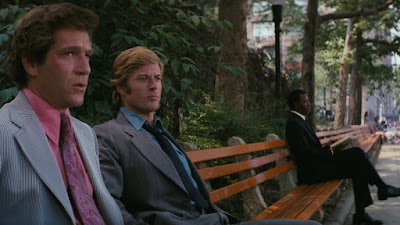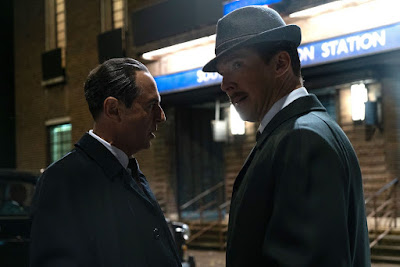In 1998 Steven Soderbergh adapted the Elmore Leonard novel “Out of Sight” into a crime caper of cool thrills, low-key comedy, and ferocious chemistry between his stars, George Clooney and Jennifer Lopez. Tucked in there too, however, was the story of a middle-aged bank robber unable to hack it in ordinary life, adept at getting tellers to hand over envelopes of cash but otherwise unable to keep his head above water in a society ruled by titans of industry. In “No Sudden Move”, then, Soderbergh, along with screenwriter Ed Solomon, essentially fashions his own Elmore Leonard novel for the screen, one giving even more prominence to the plight of low-level career criminals, trying to get theirs only to run afoul of the word and the inevitable way it turns, a familiar fatalism nevertheless given a stupendous droll kick.
As “No Sudden Move” opens, Curt Goynes (Don Cheadle), fresh out of prison in Detroit, is summoned to the barbershop of an acquaintance. Curt walks through the front door, into the backroom and then is immediately directed out the backdoor and into a waiting car, a nifty visual metaphor of underworld and ostensible respectable society’s interdependence. Curt’s mission is to babysit a family of three along with another second-class hood, Ronald Russo (Benicio del Toro), while Charley (Kieran Culkin) takes the patriarch, Matt Wertz (David Harbour), to his boss’s office to retrieve a crucial document from the safe. This all goes wrong, in more ways than one, not only leaving Curt and Russo with a bounty on their heads but trying to acquire the document for themselves to turn a small job into the score of a lifetime.
Though “No Sudden Move” spends much of its first hour withholding information, this is not simply to engender suspense but to put us on equal footing with Curt and Russo. We only ever know as much as they do, unraveling the byzantine scheme right alongside them, while the myriad twists reveal character as much as plot. The house invasion scene is telling, with what we know and what we think we know about this situation and about these people evolving moment-to-moment. When Matt insists he doesn’t have the code to the safe, Charley insists that Matt’s boss’s secretary does and that Matt is, ah, on friendly terms with her. In that moment, Matt and his wife, Mary (Amy Seimetz), exchange looks that signal his adultery which becomes more clear soon enough, just as nominal throwaway mentions of Mary’s son having no clean socks and shots of dishes piled in the sink denote her disillusionment in the role of housewife.
Even a sequence where the next-door neighbor, Dawn (Katherine Banks), inadvertently interrupts this invasion by knocking at the door is not just for suspense but set-up, a small but revelatory payoff when the movie hints on a forbidden relationship between Mary and Dawn, adding retroactive depth to the looks they exchange in that necessarily terse exchange at the front door. And this, in tandem with Seimetz’s aching performance gradually turns a crime thriller into a slow burning domestic drama too, where the costume design frequently matching the production design (a red coat and a red door) belies how underneath that flawless exterior everything is all fouled up.
Such dollops of unexpected character emerge in the turns of Cheadle and del Toro too. Though racial tension exists between Curt and Russo, that is brought to a low boil as the characters form not so much a friendship as a mutually beneficial partnership, warily keeping one eye on each other and one eye on the prize. Cheadle’s hardened gaze exudes command and trepidation in equal measure, operating predominantly in a white man’s world, walking straight into danger while always figuratively looking over his shoulder. As Russo, on the other hand, del Toro is all comically skeptical facial expressions, as if meeting a sloped world on its own terms, and though the character is cunning, he is also a drunkard. Not a drunken lout, mind you, as the small pours from his flask into coffee cups and the decanters he generously helps himself to at wealthy people’s houses all gradually, wonderfully add up in del Toro’s performance so that, by the end, hanging out a car window, it’s as if every drop of liquor Russo imbibes throughout has finally taken hold and he looks like he’s going to puke up his whole damn life.
The all-important document, which Curt and Russo do eventually acquire, both is and is not a MacGuffin. We discover what it is, or what information it contains, and though that information hardly matters, sort of summarized in a throwaway title card at the end, it plays a vital role in the emergent story nonetheless. All sorts of little details, like the document, redlining, and so-called urban renewal, are not mere window dressing but vital details that subtly add up to larger world outside the one in which Curt and Russo are trying to ride the wave without capsizing. This is even true of Matt, emerging as a hapless middleman in his own right, concocting an ostensibly life-altering scheme in connection to the same document that leaves him high and dry, his life sentence to the top-down system brought home in a scene where he quasi-confronts his boss by punching him in the face even as he simultaneously apologizes while landing those blows.

A late monologue, recited by an unexpectedly familiar face, might initially come across like so much exposition. In essence, though, he is explaining the Bigger Picture to Curt and Russo even as it goes right over their heads, embodied in the top notch actorly reactions, the way del Toro has Russo just keeps drinking and counting money, like getting paid is all that matters, and how Cheadle has Curt not quite know how to react, like he’s just seen some equation on a blackboard he can’t begin to understand. That lack of understanding, though, is also the ultimate clue. Soderbergh loves his weird angles here, all sorts of tilted shots that are not just for show but deployed in scenes and moments when the character’s world seems most out of whack. The further “No Sudden Move” goes, though, the more that world re-aligns, leading less to some sudden re-ordering of things and then the old order re-establishing itself, which in Soderbergh’s hands feels less like a dramatic A Ha than a ruefully amusing sigh.



























